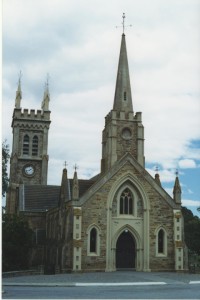 Most of the first European settlers who arrived in Strathalbyn in 1840 were very staunch Scottish Presbyterians. For several years they held worship services in private homes but – despite the demands of building houses, clearing land, putting up fences, etc. – they determined to erect a church.
Most of the first European settlers who arrived in Strathalbyn in 1840 were very staunch Scottish Presbyterians. For several years they held worship services in private homes but – despite the demands of building houses, clearing land, putting up fences, etc. – they determined to erect a church.
In 1844 the first church-school, claimed to be the second Presbyterian place of worship built in the colony of South Australia, was built on the site of the present building. This served several denominations for over three years.
By 1848 the original church was too small and so began the building of the present St Andrew’s. The 1848 structure is now part of the nave of the present building. In 1857 the church was again too small and so the transepts (completed in 1859) were added. The demand for space became pressing requiring the nave to be enlarged (in 1865) as well as a gallery, the spire and porch being added.
A prominent citizen, Edward Stirling, who had returned to Scotland, was persuaded to donate a bell for the spire. The bell, which was cast in Sheffield (UK), weighed a tonne. When it arrived in Strathalbyn, church officials realized at once that it was too heavy for the spire. Several alternatives were tried but eventually the decision was made in1869 to build a bell tower.
Mrs E J Tucker suggested (in 1895) that the tower needed a clock and so started a subscription list in the community enabling the project to be completed. The clock faces came from England and the clock was installed by Wendt’s of Adelaide.
The last of the buildings was completed in 1938, when the vestry and furnishings were donated by Mrs Tucker to celebrate 100 years of Presbyterianism in South Australia.
When church union took place in 1977, the congregations in Strathalbyn decided to use St Andrew’s as the place of worship. In 1981 the building was closed for extensive refurbishing and was reopened on 12th December 1982.
St Andrew’s, probably the most photographed building in Strathalbyn, is on the National Trust Heritage List.
(adapted from text supplied by Evelyn Glazbrook, May 2001)
